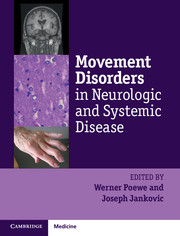Book contents
- Frontmatter
- Contents
- List of contributors
- List of videos
- List of abbreviations
- Preface
- Section I General principles
- Section II Movement disorders in systemic disease
- Section III Iatrogenic and toxic movement disorders
- Section IV Movement disorders in general neurology
- Chapter 17 Movement disorders in stroke
- Chapter 18 Movement disorders in multiple sclerosis
- Chapter 19 Movement disorders in neoplastic brain disease
- Chapter 20 Movement disorders in encephalitis
- Chapter 21 Sleep-related movement disorders
- Chapter 22 The borderland between epilepsy and movement disorders
- Chapter 23 Movement disorders associated with neuromuscular disorders and peripheral neuropathies
- Section V Systemic complications of movement disorders
- Index
- Plate Section
- References
Chapter 21 - Sleep-related movement disorders
from Section IV - Movement disorders in general neurology
Published online by Cambridge University Press: 05 April 2014
- Frontmatter
- Contents
- List of contributors
- List of videos
- List of abbreviations
- Preface
- Section I General principles
- Section II Movement disorders in systemic disease
- Section III Iatrogenic and toxic movement disorders
- Section IV Movement disorders in general neurology
- Chapter 17 Movement disorders in stroke
- Chapter 18 Movement disorders in multiple sclerosis
- Chapter 19 Movement disorders in neoplastic brain disease
- Chapter 20 Movement disorders in encephalitis
- Chapter 21 Sleep-related movement disorders
- Chapter 22 The borderland between epilepsy and movement disorders
- Chapter 23 Movement disorders associated with neuromuscular disorders and peripheral neuropathies
- Section V Systemic complications of movement disorders
- Index
- Plate Section
- References
Summary
Introduction
Nocturnal sleep disturbances, excessive daytime sleepiness, sleep-related breathing disorders, and sleep-related movement disorders are major non-motor key features of many movement disorders. Most research has focussed on Parkinson’s disease, but there is also a substantial knowledge that has been generated for other movement disorders such as atypical Parkinson syndromes, dystonias, heredoataxias, and choreatic disorders. In addition to providing an understanding of the sleep disturbances associated with these disorders, there is increasing evidence that studies of sleep may provide a unique early window into neurodegenerative disorders. For example, research over the last decade demonstrated that REM sleep behavior disorder (RBD) – a complex parasomnia characterized by dream enactment and loss of physiological REM atonia – is often the first non-motor symptom of a neurodegenerative disease. Up to 80 percent of patients initially diagnosed as idiopathic RBD will develop parkinsonism within a twenty-year observational period.
In this chapter we will provide an overview of specifically sleep-related movement disorders and start with movement disorders during sleep over motor phenomena in parasomnias to restless legs syndrome (RLS) which presents as a circadian sensorimotor movement disorder.
- Type
- Chapter
- Information
- Movement Disorders in Neurologic and Systemic Disease , pp. 314 - 332Publisher: Cambridge University PressPrint publication year: 2014
References
- 1
- Cited by



